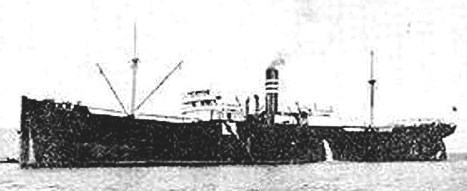RIKUGUN YUSOSEN
 JUNYO MARU, prewar)
JUNYO MARU, prewar)
JUNYO MARU:
Tabular Record of Movement
© 2012-2017 Bob Hackett and Erich Muehlthaler.
1913:
Glasgow, Scotland. Laid down as yard number 324 at Robert Duncan Co's. shipyard as a 5,065 ton cargo ship for Lang & Fulton of Greenock (Port Glasgow).
30 October 1913:
Launched and named ARDGORM.
1913:
Completed.
1917:
Sold to Norfolk & North American Steam Shipping of London.
Renamed HARTLAND POINT.
1918:
Acquired by the Johnstone Line of Liverpool, England.
1919:
Sold to Anglo-Oriental Navigation Co. Ltd., of Liverpool.
Renamed HARTMORE.
1921:
Sold to Sanyo Sha Goshi, Kaisha of Japan. Renamed SUREWAY.
1927:
Sold to Karafuto Kissen K.K. of Tokyo. Renamed JUNYO MARU.
1938:
JUNYO (ZYUNYO) MARU is sold to Baba Shoiji K.K., Tokyo. Later that year, taken over by the Japanese Government. [1]
11 August 1938:
Requisitioned by the Imperial Army (IJA) and converted to a troop transport. Assigned Army No. 654.
26 December 1939:
Released back to her ownners.
8 December 1941: The Opening of the Pacific War:
At 0630, in a radio speech, the Governor-General of the NEI, Jonkheer (Esquire) Alidius W. L. Tjarda van Starkenborgh-Stachouwer, announces the declaration of war between the Netherlands and Japan. [2]
8 March 1942:
Bandung. Governor General Tjarda van Starkenborgh Stachouwer surrenders the Dutch East Indies to the Japanese.
1943:
Re-requisitioned by the IJA. Converted to a cargo ship (A/C-AK). Assigned Army No. 5031.
31 March 1943:
At 1530, JUNYO MARU departs Woosung (near Shanghai), China for Tomie, Goto-Retto and Ukujima in a convoy also consisting of KOKI, MIYAZAKI, RYOYO, TAIAN and YUZAN MARUs escorted by destroyer KURI.
20 April 1943:
At 2000, JUNYO MARU departs Bell Buoy (Shanghai) for Japan in convoy SHI-6 also consisting of FRANCE, KOKO, MIKAGE, MIYAZAKI, RYUTO, SHINWA, TAITO TANGO (ex Dutch TOENDJOEK) and TOYOSAKA MARUs escorted by minelayer TSUBAME.
22 April 1943:
At 1800, arrives at Tomie, Goto-Retto where the convoy is dissolved.
3 May 1943:
At 0600, JUNYO MARU departs Imari Bay in convoy SA-14 also consisting of DOWA, HIDAKA, NANKA, SHOKO (MATSUE), TAMAHOKO, YASUKUNI and UGA MARUs escorted by minelayer KAMOME.
5 May 1943:
At about 0600, arrives at Hua Niao Shan.
13 May 1943:
At 1400, JUNYO MARU departs Woosung for Tomie, Goto-Retto in convoy SHI-17 also consisting of HIDAKA, NANKA, TOYOSAKA, UGA and YASUKUNI,MARUs escorted by minelayer TSUBAME.
15 May 1943:
At 1800, arrives at Tomie.
24 June 1943:
At 1630 JUNYO MARU departs Tomie, Goto Retto for Shanghai in convoy Shi-414 also consisting of DAIYA, KITSURIN, KINRYO, NANKA, KOKKO, MALAY, MISAKI, NICHINAN, SAINEI, TAITO, TOTAI, TOYOURA, and TSUSHIMA MARUs escorted by destroyer MINEKAZE and minelayer TAKASHIMA.
26 June 1943:
At about 1430, arrives at Hua Niao Shan where some of the vessels detached.
1943:
Released back to her ownners.
6 October 1943:
Re-requisitioned by the IJA. Again, assigned Army No. 654.
15 September 1944:
At about 1600, JUNYO MARU departs Tandjung Priok, the port of Batavia, Java (now Jakarta, Indonesia) for Padang, Sumatra escorted by minesweeper REISUI MARU and subchaser CH-8 with fighter aircraft anti-submarine air cover. She carries about 2,200 Dutch, English, Australian and American prisoners of war (POWs) and 4,500 Javanese romusha slave laborers. Between decks, the Japanese had inserted a layer of bamboo scaffolding to make extra decks, and the holds were crammed with bunks, three or four deep. Every level is jammed with prisoners, many of them sick, weak and emaciated.
The prisoners are to be put to work on the Pakanbaru-Muara Railway in Sumatra being built to transport coal from the west coast to the east coast of Sumatra and then to Singapore. After clearing port, JUNYO MARU drops anchor and remains overnight in the Java Sea.
16 September 1944:
Near the evening, JUNYO MARU departs westward escorted by two unidentified motor launches with fighter aircraft anti-submarine air cover.
17 September 1944:
Enters the Sunda Strait off the volcanic Island of Krakatoa and proceeds NW.
18 September 1944
Indian Ocean. W coast of Sumatra, near Mukomuko. At 1516, a plume of smoke is sighted on the horizon by periscope at 13,500 yards by
the British Eastern Fleet's 4th Submarine Flotilla’s submarine HMS TRADEWIND based at Trincomalee, Ceylon (now Sri Lanka).
At 1551, LtCdr Stephen L. C. Maydon, RN, fires four torpedoes at zig-zagging JUNYO MARU and gets two hits, one forward and the second aft. TRADEWIND the crash dives and avoids three depth-charges dropped by the escorts. Soon thereafter, Abandon Ship is ordered aboard JUNYO MARU. At 1613, she sinks by the stern at 02-52S, 101-12E.
5,620 prisoners including 1,382 men of the Royal Netherlands East Indies Army (KNIL) 10th Infantry Battalion, 56 British (mostly Royal Air Force), 8 American and 3 Australian POWs and 4,171 Javanese romusha slave laborers are killed.
Of the 5620 men aboard, only 880 survive: 680 POWs and 200 Javanese natives. Only 96 of the POWs came out of the jungle alive; but of the 200 laborers, none.
723 survivors are rescued Of the 6500 passengers, some 5,620 perished in the waters off southwest Sumatra - making this the largest maritime disaster of World War II! The 'price for survival' for the 880 that made it to the shore was employment on the railway line. Many of them did not see the end of the war. The overall survival rate for this "death-railway" was about 66% for POWs and only about 20% for romushas. About 100 Dutch nationals survived the sinking of JUNYO MARU and 10 of these died on the railway.
Author's Note:
[1] In 1937, the Japanese Government adopted the "Romaji" system of spelling. In Romaji, JUNYO MARU is ZYUNYO MARU.
[2] The NEI declaration was slightly premature. The Dutch Government in London did not issue the official declaration of war until 10 Dec '41.
Thanks to Gengoro S. Toda of Japan for info on convoy SHI-6.
Bob Hackett and Erich Muehlthaler
Back to
IJA Transports





